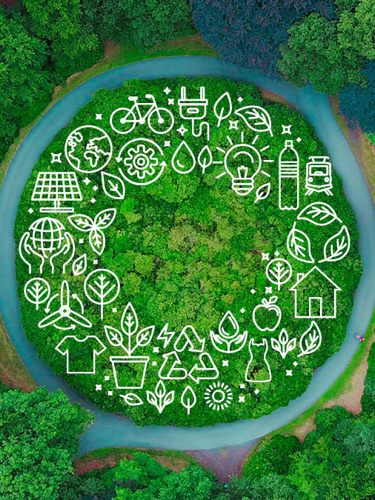Resource Effectiveness and the Circular Economy
This project focused on resource effectiveness and the circular economy, crucial matters for a future with greater global prosperity. A number of initiatives and projects around the country are examining how resource efficiency and circularity can be introduced in various sectors. But there is no unifying arena where industries and perspectives can meet. A platform is needed for resource efficiency and a circular society where industry, research and policy-makers can work together.

About the project
Resource Effectiveness and the Circular Economy
Duration: 2018-2020
Steering Committee Chair: Åke Svensson
Project Managers: Caroline Ankarcrona, Jan Nordling
Funding providers: Tillväxtverket, Vinnova, Svenskt Näringsliv, Vasakronan, Åforsk, Teknikföretagen , IKEM, Formas och Mistra.

A system-wide vision for the resource flows in society is needed to achieve a more efficient resource use. Improving material management efficiency and finding new commercial opportunities requires transitioning from a linear material flow to a circular one. A comprehensive approach is needed where producer–user–recycler–new producer are all included in the production chain. Cooperation is needed between different actors, as well as regulatory change to create incentives and the right market conditions, increase digitalisation and generate innovation and new business models focusing on resource efficiency.
In cooperation with 45 companies, IVA ran its project Resource Efficient Business Models – Greater Competitiveness between 2014 and 2016. The project highlighted great opportunities to make the Swedish economy more resource efficient through multiple commercial opportunities.
From 2018 until the spring of 2020 the succeeding project Resource Effectiveness and Circular Economy has been running at IVA. The project has built upon the previous one, working with the same sector breakdown and further exploring the commercial opportunities that were identified. The project has been divided into five sub-projects: premises, mobility, textiles, food and plastics.
Project goals
Three goals have been set up for the project. First, to create a platform for resource effectiveness and a circular economic – based on the initiatives that are under way. Secondly, to draw conclusions for policies, research and industry on which choices Sweden has make. And thirdly, to create cooperation and forward motion.
Focus of the sub-projects
Premises
The project will analyse opportunities and obstacles in optimising the use of premises. There are obstacles relating to incentives, legislation and rules, but they are also in the form of the social norms and habits of users, producers, sellers and lessors. Fresh ideas and control mechanisms are needed, as well as clear communication of good examples and practical experiences. Concrete solutions are required to address the technical, legal and political aspects.
Mobility
Technology to increase shared mobility already exists or will be developed and is not seen as an obstacle for improvement. The main obstacles are business models and customer behaviour. How can individuals, companies, municipalities and the public sector start to increase the exent to which passenger and freight transport solutions are shared? What value does mobility create in society? How can we achieve this from a resource effectiveness perspective?
Textiles
The textile industry is fragmented and has numerous stakeholders with different goals, desires and opinions. Several projects are under way, but it is clear that many of the initiatives are at the operationl level and lack a system perspective. One obstacle is that companies are still working linearly and that control mechanisms and laws are designed for a linear system. The conclusion is that a system transformation is needed to achieve circularity.
Food
The focus is on concrete steps towards reduced food waste throughout the food supply chain. The project is working on creating industry-wide standards, mapping the food supply chain flows and identifying the most serious sources of waste and resource loss, and how to fix this. Access to data in the food supply chain is inadequate today and is needed in order to properly tackle food waste in a systematic way.
Plastics
The project is analysing the plastics flow. There is a significant loss in value at recycling stations where different types of plastics are mixed. Better recycling systems for similar flows are needed in order to retain the value of the materials, and new technical solutions need to be identified and applied. New standards for plastics and use of recycled plastics are needed. Barriers identified include market failures which lower the incentive to increase resource efficiency, and poor traceability which reduces the market for actors who can create value networks for optimal management of plastics and raw materials.
Steering committee
- Åke Svensson (Chairman)
- Tim Brooks, Swedish Agency for Economic and Regional Growth
- Thomas Nilsson, Mistra
- Björn Risinger, Swedish Environmental Protection Agency
- Annica Sohlström, Swedish National Food Agency
- Björn Stigson, IVA
- Henrik Sundström, Electrolux
- Martin Svensson, Vinnova
- Cecilia Tisell, Swedish Consumer Agency
- Caroline af Ugglas, Confederation of Swedish Enterprise
- Anders Wijkman, ÅI
- Tuula Teeri, IVA (co-opted)
- Ola Alterå, Swedish Climate Policy Council (co-opted)
Sub-project chairs
- Anna Denell, Vasakronan, and co-chairman Mattias Höjer, KTH – Premises
- Magnus Huss, IKEM – Plastics
- Ann-Karin Modin Edman, Arla – Food
- Jan-Eric Sundgren, Teknikföretagen – Mobility
- Cecilia Tall, TEKO – Textiles
Sub-project management
- Liv Fjellander – Premises
- Peter Stigson – Plastics
- Kristoffer Gunnartz – Food
- Jacqueline Oker-Blom – Mobility
- Caroline Hofvenstam – Textiles


